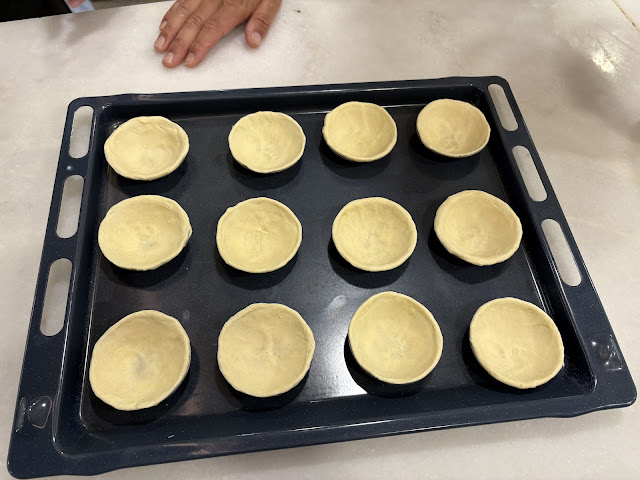If you've never eaten a pastel de nata (pastéis is the plural), a signature dessert of Portugal, you are really missing out on one of life's great treats. We have a large population of Portuguese people living in and around Newark, so they're easy to find here in New Jersey. But eating and making them where they were first created was like finding the mother lode. Pastéis de nata tarts are pastries inspired by an original recipe called Pastéis de Belém, which were created before the 18th century by Catholic monks at the Jerónimos Monastery in Belem (a Lisbon neighborhood).
In the aftermath of the liberal revolution of 1820, following the dissolution of religious orders and in the face of the impending closure of many convents and monasteries, the monks started selling pastéis de nata at a nearby sugar refinery to bring in revenue. In 1834, the monastery was closed and the recipe sold to the sugar refinery, whose owners opened the Fábrica de Pastéis de Belém in 1837. The descendants own the business to this day.
Naturally, we had to try them at the source (where I was also inspired to paint the scene).
Cradled in a crispy, buttery pastry, and filled with a silky, custard interior, you'll find it hard to resist eating more than one of these luscious confections.
My husband, my daughter-in-law and I signed up for a class in Belem on our recent trip, to learn to make these treats. It was lots of fun, and they were easier to make than they look. First you need to make the pastry. Yes, you could buy puff pastry, but there's nothing like homemade and it really wasn't that difficult at all. The most important thing was to refrigerate the dough before shaping it into the tart tins. There's a lot of butter in the dough and you don't want it oozing out because it starts out too warm.
Then pour the filling into the molds, about 3/4 of the way to the top and place them in the oven.
Here are the results of our labors. Optional: dust with powdered confectioner's sugar and/or cinnamon.
And here are our fellow classmates, who were visiting from Boston and from London.
Pastéis de Nata
For the Puff Pastry230 grams (1 3/4 cups) of low protein flour
120 grams (1/2 cup) of cold water
4 grams (3/4 teaspoon) of fine salt
160 grams (2/3 cup) of a square of butter proper for puff pastry (high fat, like French or Irish butter)
1. In a large bowl combine the flour, water and salt until you get a dough
consistency.
2. Change for a working surface and knead for 3 minutes. Wrap in cling
film and let it rest in the fridge for 10 minutes
3. With a rolling pin extend the dough creating 4 wings with a lump in
the middle. The wings should have size to cover the square of butter.
4. Place the butter in the center of the dough, close with the wings and press.
5. With a rolling pin extend the dough until get a rectangle shape
with 5mm thick (a little over 3/16 inch)
6. Fold in the pastry in three parts.
7. Repeat steps 5 and 6 one time
8. For the final fold divide the dough in 4 parts instead of 3.
9. Sprinkle the surface of the dough with water. Roll and press a bit
to form a roll. Refrigerate for 20 minutes.
10. Cut 8 mm (a teeny bit more than 1/4") thick slices of puff pastry. You should get 12 or a little more slices.
11. Place a disc of dough on the bottom of the tins and with your
thumbs press and stretch the dough until it completely covers the tin
interior.
For the Custard
200 ml of whole milk (3/4 cup plus two tablespoons)
200 ml of cream (35% fat content) (3/4 cup plus two tablespoons)
120 gr of sugar (1/2 cup)
1 tablespoon of cornstarch
2 egg yolks
Cinnamon stick
Lemon zest
1. Dissolve the cornstarch with a part of milk.
2. In a pot, combine everything, except the egg yolks. Bring to a low
simmering just to infuse the aromatics and thicken it up to a double
cream texture (6 minutes)
3. Let it cool to room temperature, before adding the beating egg yolks.
4. Fill up the tins up to ¾.
5. Bake at maximum heat (250ºC or 500 degrees Fahrenheit). Place the tray in
the middle of the oven, fan off with heat coming from top and bottom
either.
6. Should bake for 12/15 minutes. First the puff pastry will start to
flake. After a few minutes the custard will rise and form a dome. When
the black dots appear on top, Pastéis de Nata are done.









































